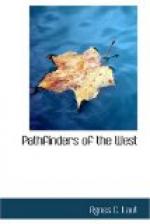The spring of 1659 found the explorers still among the prairie tribes of the Mississippi. From these people Radisson learned of four other races occupying vast, undiscovered countries. He heard of the Sioux, a warlike nation to the west, who had no fixed abode but lived by the chase and were at constant war with another nomadic tribe to the north—the Crees. The Crees spent the summer time round the shores of salt water, and in winter came inland to hunt. Between these two was a third,—the Assiniboines,—who used earthen pots for cooking, heated their food by throwing hot stones in water, and dressed themselves in buckskin. These three tribes were wandering hunters; but the people of the fire told Radisson of yet another nation, who lived in villages like the Iroquois, on “a great river that divided itself in two,” and was called “the Forked River,” because “it had two branches, the one toward the west, the other toward the south, . . . toward Mexico.” These people were the Mandans or Omahas, or Iowas, or other people of the Missouri.[13]
A whole world of discoveries lay before them. In what direction should they go? “We desired not to go to the north till we had made a discovery in the south,” explains Radisson. The people of the fire refused to accompany the explorers farther; so the two “put themselves in hazard,” as Radisson relates, and set out alone. They must have struck across the height of land between the Mississippi and the Missouri; for Radisson records that they met several nations having villages, “all amazed to see us and very civil. The farther we sojourned, the delightfuller the land became. I can say that in all my lifetime I have never seen a finer country, for all that I have been in Italy. The people have very long hair. They reap twice a year. They war against the Sioux and the Cree. . . . It was very hot there. . . . Being among the people they told us . . . of men that built great cabins and have beards and have knives like




